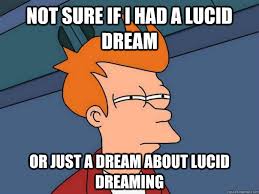What is Lucid Dreaming? Discover How to Trigger Your First Lucid Dream

Have you ever been in a dream so vivid that you realized, mid-sleep, that you were dreaming? That’s called lucid dreaming , and it’s like having a backstage pass to your subconscious mind. In this state, you’re aware that you’re dreaming—and with practice, you can even take control of the dream itself. Whether you’re flying over mountains, meeting your favorite celebrity, or conquering your deepest fears, lucid dreaming opens up endless possibilities.
But how does it work, and what triggers these awe-inspiring dreams? Let’s dive into the science, techniques, and benefits of lucid dreaming—and show you how to start exploring this fascinating world tonight.
What Happens During a Lucid Dream?
Lucid dreaming occurs during REM (Rapid Eye Movement) sleep, the stage of sleep where most dreaming takes place. During REM, your brain activity spikes, mimicking wakefulness—but your body remains in a state of paralysis to prevent you from acting out your dreams.
In a lucid dream, something extraordinary happens: the part of your brain responsible for self-awareness (the prefrontal cortex) becomes active. This allows you to recognize that you’re dreaming and, in some cases, manipulate the dream environment. It’s like being the director of your own movie—except the script is written by your subconscious.
The Science Behind Lucid Dreaming
Research shows that lucid dreaming isn’t just a mystical experience—it’s backed by neuroscience. Studies using EEG scans reveal that during lucid dreams, the brain exhibits a unique blend of wake-like and sleep-like activity. This hybrid state may explain why lucid dreamers can think logically and make decisions while still immersed in the dream world.
Fun Fact: Famous surrealist artist Salvador Dalí used lucid dreaming as a wellspring of creativity. He’d nap with a spoon in his hand, and when he drifted off, the spoon would clatter to the floor, waking him just enough to jot down his dream-inspired ideas.
How to Trigger Lucid Dreams: Techniques That Work
Ready to try lucid dreaming for yourself? Here are some proven techniques to help you unlock this skill:1. Keep a Dream Journal
One of the simplest ways to increase your chances of lucid dreaming is to record your dreams every morning. Writing them down helps you spot recurring patterns and improves your dream recall—a crucial step in recognizing when you’re dreaming.
Pro Tip: Place a notebook or use a notes app next to your bed. As soon as you wake up, jot down everything you remember, no matter how fragmented.

2. Practice Reality Checks
- Reality checks train your mind to question whether you’re awake or dreaming. Over time, this habit will carry over into your dreams, triggering lucidity. Try these simple reality checks throughout the day:
- Pinch Your Nose Test: Pinch your nose and try to breathe through it. If air flows through, you’re dreaming!
- Clock Test: Look at a clock, look away, then look back. In dreams, the time often changes unpredictably.
3. Use the MILD Technique (Mnemonic Induction of Lucid Dreams)
- Developed by Dr. Stephen LaBerge, the MILD technique involves setting an intention to become aware in your dreams. Before falling asleep, repeat a phrase like:
- “I will know I’m dreaming.”
- “Tonight, I’ll explore my dreams.”
This primes your subconscious to recognize dream signs and achieve lucidity.
4. Meditate Before Bed
Meditation calms the mind and enhances self-awareness—two key ingredients for lucid dreaming. Spend 5–10 minutes focusing on your breath or visualizing a peaceful scene before sleep. You might find yourself slipping directly into a lucid dream!
Benefits of Lucid Dreaming
- Lucid dreaming isn’t just fun—it can also improve your mental health, creativity, and problem-solving skills. Here’s how:
- Overcome Nightmares: By taking control of your dreams, you can confront and transform scary scenarios, reducing anxiety.
- Boost Creativity: Artists, writers, and musicians have long used lucid dreams as a source of inspiration.
- Enhance Confidence: Practicing real-life situations in your dreams (like public speaking) can boost your confidence in waking life.
However, it’s important to approach lucid dreaming responsibly. Spending too much time trying to induce lucid dreams can disrupt your sleep cycle, so balance is key.
Common Questions About Lucid Dreaming
Still curious? Here are answers to some frequently asked questions:
Is Lucid Dreaming Safe?
Yes, for most people, lucid dreaming is perfectly safe. However, those prone to sleep disorders should consult a doctor before attempting advanced techniques.
Can Anyone Learn to Lucid Dream?
Absolutely! While some people naturally experience lucid dreams, anyone can learn with patience and practice.
How Long Does It Take to Start Lucid Dreaming?
Results vary. Some people achieve their first lucid dream within days, while others may take weeks or months. Consistency is key!
Myth-Busting: Separating Fact from Fiction
Let’s clear up some common misconceptions about lucid dreaming:
Myth: “Lucid dreaming is dangerous.”
Fact: Research shows that lucid dreaming is generally safe when practiced responsibly. It’s a natural phenomenon that many people experience spontaneously.
Myth: “You can get stuck in a lucid dream.”
Fact: Unlike movies suggest, you can always wake up from a dream naturally. No one has ever been “trapped” in a dream.

Start Your Lucid Dreaming Journey Tonight!
Lucid dreaming is a doorway to unlimited possibilities. With a bit of practice and persistence, you can unlock this incredible skill and explore the depths of your imagination.
So why not give it a shot? Try keeping a dream journal, practicing reality checks, or meditating before bed. And don’t forget to share your experiences in the comments below—we’d love to hear about your adventures!



